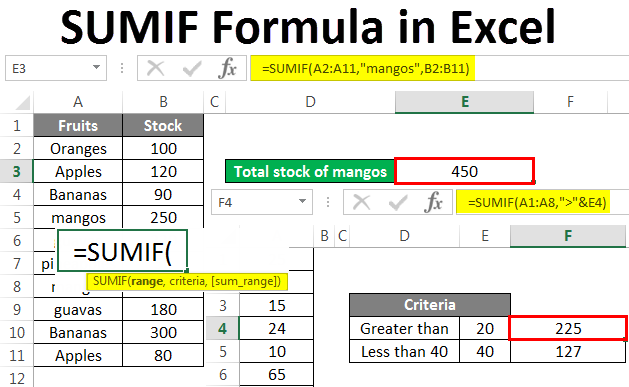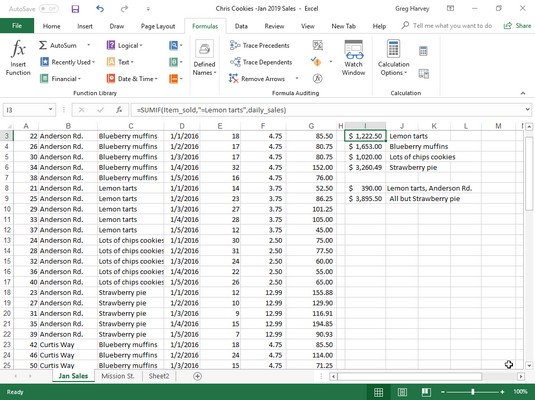The Definitive Guide for Sumif Between Two Dates
If "empty" indicates cells which contain absolutely nothing - no formula, no absolutely no length string returned by a few other Excel feature, then use "=" as the requirements, like in the following SUMIF formula: =SUMIF(A 2: A 10,"=", C 2: C 10) If "blank" includes absolutely no size strings (for instance, cells with a formula like =""), after that use "" as the requirements: =SUMIF(A 2: A 10,"", C 2: C 10) Both of the above solutions evaluate cells in column An as well as if any kind of vacant cells are found, the equivalent worths from column C are included.


Normally, you use the SUMIF feature to conditionally sum values based on dates similarly as you use text and numeric criteria. If you want to sum worths representing the days that are above, less than or equivalent to the day you specify, then use the Criteria Formula Example Summary Amount values based upon a specific day.
Sum values if a corresponding date is higher than or equivalent to an offered date. =SUMIF(B 2: B 9,">=10/29/2014", C 2: C 9) Amount values in cells C 2: C 9 if a corresponding day in column B is higher than or equivalent to 29-Oct-2014. Amount worths if a corresponding date is more than a date in an additional cell.
In situation you want to sum worths based on a present date, then you have to make use of Excel SUMIF in combination with the TODAY() feature as shown listed below: Criteria Formula Instance Amount values based on the current date. =SUMIF(B 2: B 9, TODAY(), C 2: C 9) Sum values representing a prior day, i.e.
What Does Sumif Excel Do?
=SUMIF(B 2: B 9, "" & TODAY(), C 2: C 9) Amount values if a date takes place in a week( i.e. today +7 days).=SUMIF (B 2: B 9, "="& TODAY( )+7, C 2: C 9) The screenshot listed below highlights exactly how you can utilize the last formula to find the total amount of all items that ship in a week. In Excel 2007 as well as greater, you can also use the SUMIFS function that permits numerous requirements, which is also a better alternative. While the last is the subject of our next write-up, an example of the SUMIF formula complies with below: =SUMIF(B 2: B 9, ">=10/1/2014", C 2: C 9) - SUMIF(B 2: B 9, ">=11/1/2014", C 2: C 9) This formula summarize the values in cells C 2: C 9 if a date in column B is in between 1-Oct-2014 as well as 31-Oct-2014, inclusive.
The very first SUMIF function adds up all the cells in C 2: C 9 where the equivalent cell in column B is better than or equivalent to the start date (Oct-1 in this example). After that you just need to subtract any kind of values that fall after the end date (Oct-31), which are returned by the second SUMIF function.

Intend, you have a recap table of regular monthly sales. Considering that it was settled from a numbers of local reposts, there are a couple of records for the very same item: So, exactly how do you discover the total amount of apples sold in all the states in the past three months? As you remember, the measurements of sum_range are determined by the measurements of the array criterion.
This is not what we are searching for, right? The most sensible and also simplest solution that recommends itself is to produce an assistant column that computes specific sub-totals for each and every row as well as then reference that column in the sum_range standards. Proceed as well as place a straightforward AMOUNT formula in cell F 2, then load down column F: =AMOUNT(C 2: E 2) Afterwards, you can create a typical SUMIF formula such as this: =SUMIF(A 2: A 9, "apples", F 2: F 9)or=SUMIF(A 2: A 9, H 1, F 2: F 9) In the above solutions, sum_range is precisely of the exact same size as range, i.e
Sumif Not Equal Fundamentals Explained
. There could be a number of reasons Excel SUMIF is not benefiting you. Sometimes, your formula does not return what you expect only due to the fact that the data key in a cell or in some debate isn't suited for the SUMIF feature. So, here is a list of points to examine. The very first (range) and 3rd (sum_range) specifications of your SUMIF formula need to always be a variety referral like A 1: A 10.
Appropriate formula: =SUMIF(A 1: A 3, "blossom", C 1: C 3) Incorrect formula: =SUMIF( 1,2,3, "flower", C 1: C 3) As nearly any other Excel feature, SUMIF can reference other sheets and also workbooks, provided they are currently open. For instance, the adhering to formula will certainly sum the values in cells F 2: F 9 in Sheet 1 of Book 1 if a matching cell in column A if the very same sheet contains "apples": =SUMIF( [Schedule 1. xlsx] Sheet 1!$A$ 2:$A$ 9,"apples", [Schedule 1. xlsx] Sheet 1!$F$ 2:$F$ 9) Nevertheless, this formula won't work as quickly as Book 1 is shut.
As noted in the beginning of this tutorial, in contemporary versions of Microsoft Excel, the variety as well as sum_range criteria does not have to be just as sized. In Excel 2000 and older, unequally sized variety and sum_range can cause issues. However, even in one of the most recent variations of Excel 2010 as well as Excel 2016, complicated SUMIF formulas where sum_range has less rows and/or columns than variety are picky.

If you've populated your workbook with complicated SUMIF formulas that reduce your Excel, have a look at The Excel SUMIF examples defined in this tutorial just touch on several of the standard uses of this feature. In the following article, we'll investigate sophisticated solutions that harness the real power of SUMIF as well as SUMIFS as well as allow you amount by multiple criteria.

The 9-Minute Rule for Sumif Between Two Dates
I intend to do an amount of cells, with several standards. I have actually discovered that the way to do it is with sumproduct. Like this =SUMPRODUCT((A 1: A 20="x")*(B 1: B 20="y")*(D 1:D 20)) The trouble I am having is that the A row contains joined cells (which I can't alter) In my situation I intend to do an amount of every number in the offered row under both 2010 as well as 2011 conference my standards. sumif excel with dates sumif excel yes excel sumif isblank